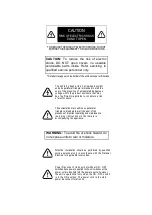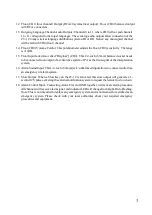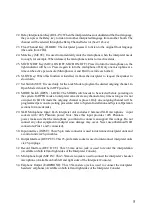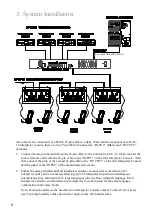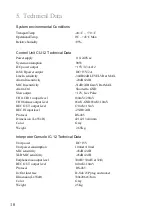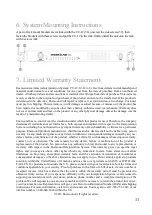
4. System Operation
4-1 Open Mode
This is the most widely used mode and will suit the majority of your interpretation needs.
For the system to operate in Open Mode, the Mode switch must be in the OPEN position and
the Set switch must be in the OFF position.
When the interpreter selects the desired outgoing channel, the light indicator will turn green
while the channel is not occupied. If the key indicator flashes red when pressing the outgoing
channel key, it means that the channel is occupied by another unit and the interpreter has to wait
until the other interpreter occupying the channel either releases the channel or turns off their
microphone. Note: If the microphone is OFF, the active channel will be released if an interpreter
from another booth selects the same channel.
If there is a need to deselect the active outgoing channel, press the Enter/ Clear key.
When the output channel is selected, the interpreter must push the MIC ON/OFF key to
activate or deactivate the microphone. To momentarily mute the microphone, the interpreter
can press and hold the “MUTE” key.
If the SPEAK SLOWLY function is correctly installed with additional external equipment, when the
speaker speaks too fast for the interpreter to follow, the interpreter can press the “SLOW” key to
remind the speaker to slow down. A 1 second 12V Pulse will come out from the control unit CU-
12 to activate the external notification system.
The example below will help to explain how to operate the system in a conference setting
using interpreter consoles in open mode with “direct” and “relay” interpretation.
Note: It is always necessary to utilize a PA System (Sound System) in conjunction with the
interpretation system so that any speech to be interpreted can be sent to the interpretation
consoles via the FLOOR input.
•
Event type: Trilingual conference in the U.S.A with direct and relay interpretation
•
Main language: English
•
Other languages: Spanish and French
•
Number of interpretation booths: 2 (one interpreter console IC-12 per booth)
•
Booth #1: “Spanish” Booth from “English into Spanish” and from “Spanish into English”
•
Booth #2: “French” Booth from “English into French” and from “French into English”
•
Assigned channels: English=CH1 Spanish=CH2 French=CH3
Scenario 1- The speaker talks in English or the audience asks a question in English:
The Spanish interpreter will perform direct interpretation into Spanish. Her outgoing channel
selector should be in CH2 (Spanish) so that her voice is routed to the Spanish channel.
She will listen to the original floor audio; therefore, her “FLOOR” Channel Key should be
selected.
The French interpreter will perform direct interpretation into French. Her outgoing channel
selector should be in CH3 (French) so that her voice is routed to the French channel.
She will listen to the original floor audio; therefore, her “FLOOR” Channel Key should be
selected.
Scenario 2- The speaker talks in Spanish or the audience asks a question in Spanish:
The Spanish interpreter will perform direct interpretation into English. Her outgoing channel
selector should be in CH1 (English) so that her voice is routed to the English channel. She
will listen to the original floor audio; therefore, her “FLOOR” Channel Key should be
selected.
8
8



